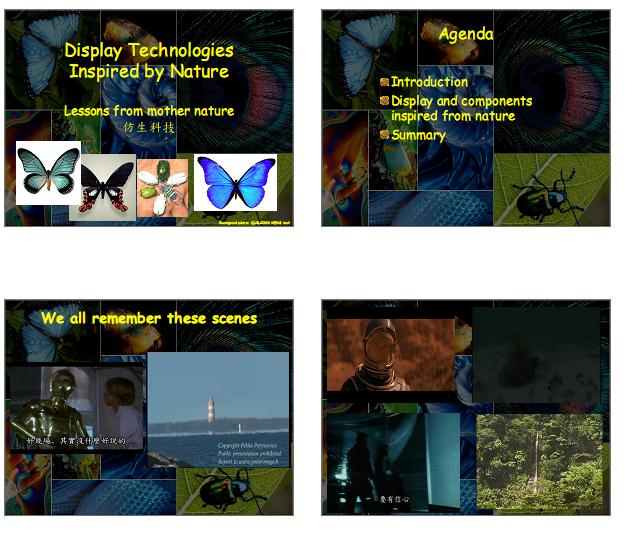|
|
马上注册,结识高手,享用更多资源,轻松玩转三维网社区。
您需要 登录 才可以下载或查看,没有帐号?注册

x
PDF格式、英文、图片文字资料。13页
1 C) V4 K d3 v; c5 zDisplay Technologies
6 E3 d; C2 `$ [$ B0 U2 u/ TInspired by Nature$ p- k6 H+ J0 F
Lessons from mother nature. w1 l" S) Y) o0 \) k; }
仿生科技# S2 F* V$ E# H% x
Background picture: QUALCOMMMEMS tech& ^2 d- f0 N$ z- O! j1 v; ]& B
Agenda
$ w1 v5 W b8 LIntroduction; R8 ~/ d5 ?. X0 T+ Y4 b! b
Display and components
; N$ k+ o- ]. i! Z- \inspired from nature. _( B/ {4 |% Z/ x" I& z
Summary! V9 [6 v! j2 U1 J) [# k a
We all remember these scenes, H, Z% J3 H: o& y
Why are things colored
0 t! H! ]( q" Y7 ~4 ~% Z0 YCourtesy of Dr. R.O. Prum" |5 H' S* F1 m, i( ?* s* V
Kurt Nassua, in his book The Physics and & H/ a) q- r/ V
Chemistry of Color, identifies 15 ! G( f) U; |. z- L
different causes of color
& @. `1 W3 u7 D8 x2 k6 P+ V& c- L ^5 w1. Incandescence8 V* t1 X2 Z3 x& {/ T3 k6 F: w i6 p
2. Gas Excitations. Z3 o, s6 d! a( u3 I
3. Color from Vibrations and Rotations
0 f8 W0 d6 {0 P; {1 {* y4. Transition Metals in a LigandField/ j1 Z5 C: g' E& b7 U* g
5. Organic Molecules
" Z4 v( j Y3 Q* F5 j$ [& E$ O- x: X6. Charge Transfer% j0 g+ d5 i. @' o& X! g, h' s2 H* W0 l R
7. Metals3 R# g Y, B; j" }: u2 ]7 N
8. Semiconductors. O( [9 Z/ q" F( b# B; `6 h) m @& L! M
9. Doped Semi-conductors
5 J: q4 ~1 g5 e4 O10. Color Centers4 S- Q2 c1 [" @ L% q
11. Dispersive Refraction
+ g: p* l& ~: g( u% v& T$ g- q12. Polarization& f/ r! D* {$ _; ~, V/ `5 u& [
13. Scattering
$ y! u4 V- I8 d7 Q# ?6 w, q14. Interference
& G- f8 J7 a+ f7 K15. Diffraction |
-

|